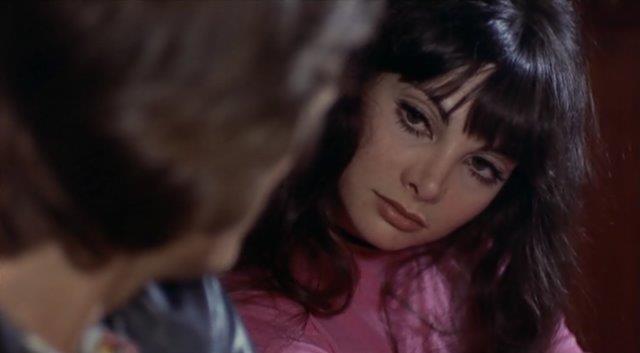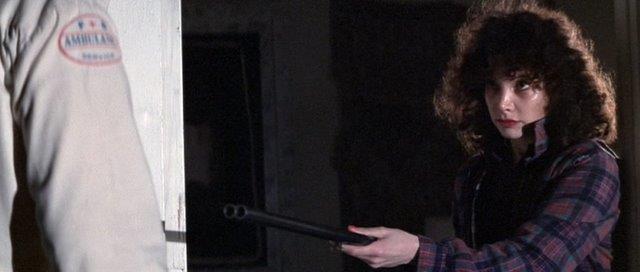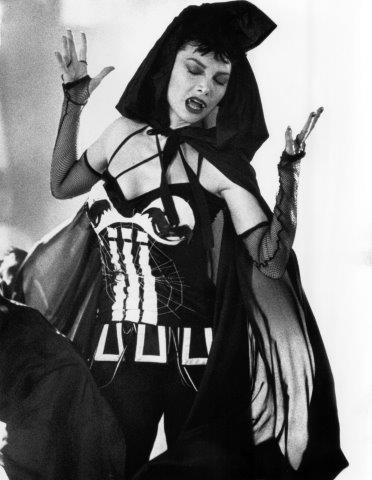From the go-go dancing birdcages of the 1960s, through to her recent gig choreographing the dance sequences for Quentin Tarantino’s Once Upon a Time…In Hollywood (2019), Basil’s career has ever-evolved, and she remains as vital, and as full of boundless energy and youthful exuberance, as she has at any point in her remarkable fifty-plus year career.

Born Antonia Christina Basilotta in Philadelphia on September 22, 1943, Toni Basil was the child of an acrobatic comedian mother and a father who conducted orchestras at the Sahara Hotel and Casino in Las Vegas. When the family moved to Vegas for her father’s work, Basil attended Las Vegas High School and, already known by her Toni nickname, became a cheerleader for the school football team, the Wildcats. A keen professional dancer since childhood, the turning point in Basil’s early career came when she landed a job as an assistant choreographer to David Winters, as well as appearing regularly as a dancer on the pop music television show Shindig!, which ran from 1964-66. The classic concert film The T.A.M.I. Show (1964) was another project which Basil worked on with Winters. The mid-sixties saw her break into feature films, with uncredited but impressive roles as a dancer in Viva Las Vegas (1964), the Rat Pack vehicle Robin and the 7 Hoods (1964), and the teen comedy musical Pajama Party (1964) starring Annette Funicello and Tommy Kirk (which was an off-shoot of the popular series of Beach Party films).
Basil also choreographed a couple of notable teen drive-in movies during this period. Village of the Giants (1965) was an outrageous adaptation of the classic H. G. Wells novel The Food of the Gods, directed and co-written by Bert I. Gordon (who became known to fans as Mr. B.I.G., due his penchant for films featuring oversized humans and monsters). The movie starred future Hollywood heavyweight Ron Howard as Genius, a brainiac kid who accidentally invents a substance he dubs “Goo”, which when consumed causes animals (including cats, ducks, and a tarantula) to rapidly grow to enormous size. When a bunch of trouble-making teenagers (led by Beau Bridges) drift into town and stumble upon Genius’s stash of Goo, they ingest it and soon find themselves thirty feet tall (and naked), planning to use their newfound power to torment and take over the locals. It’s wild stuff, powered along by a great soundtrack by Jack Nitzsche, and an appearance by the Beau Brummels, who perform their song “Woman” (accompanied by giant dancing ducks!). Nitzsche’s bass-driven instrumental theme for Village of the Giants was later pilfered by Tarantino for the opening credits of Death Proof (2007). Toni Basil not only choreographed the dance sequences for the film (including the memorable dance which the giant teens perform for the stunned townsfolk), she also appears in the film as Red, a raven-haired go-go dancer who is sent along to distract the oversized teenagers (at least the male ones) with one of her wildly impressive routines.
The Cool Ones (1967) was a music industry satire loosely based on the eccentric (and now deceased, convicted killer) Phil Spector, the genius but volatile producer famed for creating the iconic “wall of sound” in the songs that he produced (perhaps best represented by the Ronettes’ 1963 hit “Be My Baby”). Roddy McDowall played the Spector character, a shady but rich young rock music promoter and manager, who sets up a romantic liaison between an up-and-coming young female pop singer and dancer and a male crooner who’s on the decline, all to help promote a television show.
The late-sixties saw Basil appearing in two genuine counterculture classics, Head (1968) and Easy Rider (1969). Co-written by a young Jack Nicholson, Head was a very trippy film starring the television rock band The Monkees, whose once-popular musical sitcom had been cancelled by NBC earlier in the year. At the time, Head was a box-office disaster and only served to further alienate the band’s dwindling teenage fanbase, but the movie started to find reappraisal on home video in the mid-eighties, and is now noted for its satirical aspects (the movie essentially sends-up the whole Monkees’ pre-fab phenomenon), not to mention its experimental style and terrific soundtrack, which features some of the band’s best and most mature songs, including the psychedelic classic “Porpoise Song (Theme from Head)”, the driving blues beat of “Circle Sky” (accompanied in the film by genuine Vietnam atrocity footage), and the vaudevillian jazz swing of “Daddy’s Song”, a number written by Harry Nilsson and sung by Davy Jones. In the film, the song is performed by Jones, who dances around a bare set that alternates via quick cuts between light and dark, while Jones’ suit and tails also switches between black and white. Basil makes her entrance halfway through the song, dancing with Jones in a performance which is like a psychedelic Rogers and Astaire. While helped by the rapid editing, it was a tough and demanding sequence to shoot, with Jones putting in extra hours of rehearsal in order to get it right. Naturally, Basil was also the choreographer of this outstanding piece, along with several other dance sequences throughout the film.

Toni Basil in Easy Rider
In Easy Rider, Basil had a straight acting role as Mary, one of the prostitutes which Wyatt (Peter Fonda) and Billy (Dennis Hopper) visit when they ride into New Orleans, before taking her and her companion Karen (Karen Black) on a wild LSD-fuelled trip through the town during Mardi Gras. The sequence culminates with the quartet having sex, freaking out and pondering life and death whilst exploring the old New Orleans Cemetery. Basil would work again with Hopper on two of his other directorial features, playing Rose the actress in his legendary The Last Movie (1971), and a mob wife in an uncredited part in the offbeat crime thriller Catchfire (aka Backtrack, 1990). Admired by many of America’s new independent filmmakers, Head director Bob Rafelson cast Basil as young gay woman Terry Grouse in his superb, and devastating, drama Five Easy Pieces (1970).

Toni Basil in Mother, Jugs & Speed
One of Toni Basil’s best seventies film roles was in Peter Yates’ Mother, Jugs & Speed (1976). A biting black comedy drama set amongst the highly competitive world of privatised ambulance services in Los Angeles, the film starred Bill Cosby, Raquel Welch, and Harvey Keitel as the three title characters, as well as an hilarious turn by Larry Hagman as a sleazy, oversexed ambulance driver. Basil makes a brief but very memorable appearance as an on-edge junkie in the pangs of full withdrawal, who calls an ambulance to her home with the intent of robbing it of any morphine or other drugs on board, but ends up shooting dead Leroy (Bruce Davidson), the pot-smoking partner of wise-cracking star driver Mother (Cosby). After exchanging some gunfire with Mother, Basil’s unnamed character turns the shotgun on herself when she hears police sirens approaching in the distance. Looking pale and sweaty, with dark red rings under her eyes and a wild nest of curly black hair, Basil certainly looks the part here, but she also conveys a convincing nervousness in her performance, as well as a degree of pleading hopelessness.
Basil first dabbled in the recording studio in the mid-sixties, performing the very Northern Soul-inspired theme song from Bruce Conner’s short film Breakaway (1966), which she also starred in as a go-go dancer. A&M released “Breakaway” as a 45 single, with Basil performing another song, “I’m 28”, on the B-side. Written by future 10CC co-founder Graham Gouldman, “I’m 28” is a near-perfect mid-sixties pop ballad, Basil bringing impassioned life to the lyrics, which examine the fears of growing old in an era of youth culture.
While she occasionally showed up to sing on seventies American television shows like Saturday Night Live and The Merv Griffin Show, by 1980 Toni Basil was preparing to once again put her voice down on wax, though this time in a much more dynamic and pronounced way. Basil signed to the UK label Radialchoice, who released her debut album, Word of Mouth, in that country in May of 1981. The lead-off song from the album was a Mike Chapman/Nikki Chinn composition called “Mickey”, which had originally appeared as a song called “Kitty”, recorded and released as an album track in 1979 by UK pop band Racey. Basil changed the title and added a classic cheerleader chant to it, and the song was released accompanied by a clever music video, which the artist herself choreographed and directed. The video depicted Basil, wearing her old Las Vegas High School cheerleader outfit, performing the song to an energetic dance routine, accompanied by members of the Los Angeles-based Carson High School cheerleaders, whom Basil had become acquainted with at a cheerleading competition and had been waiting to find the perfect project to use them on.
While “Mickey” did not chart upon its initial UK release, it was reissued in January of 1982 in the wake of rising interest in creative music videos. This time, the song well and truly caught on, and “Mickey” eventually rose to number 2 on the UK singles charts, while in Australia it managed to go one higher. Word of Mouth was then picked for US release by Chrysalis, who issued it (with an altered track listing) in April of 1982. By the end of the year, “Mickey” was soon sitting at the top of the American Billboard Hot 100, while the album bumped the top twenty and went platinum. The newly established MTV naturally went wild over the video clip, playing it on heavy rotation and was no doubt a huge contributing factor in the success of the song in that country.

Right from its inception, Basil planned Word of Mouth to be as much a visual project as an audio one. To that end, a home video version of the album was released on VHS and Beta, containing seven conceptual music videos of songs from the record, all choreographed and directed by Basil: “Mickey”, “Nobody”, “Little Red Book”, “Time After Time”, “Be Stiff”, “Space Girls” and “You Gotta Problem”. Basil came into the Word of Mouth video project already with some noteworthy experience under her belt. In 1980, she choreographed and co-directed (with singer David Byrne), the music video for Talking Head’s classic “Once in a Lifetime”. She had also choreographed American Graffiti (1973) and The Rose (1979) with Better Midler, not to mention all the ground-breaking, street dance inspired routines she had performed on television in the seventies, with her troupe The Lockers (whose roster of members included the late Adolfo “Shabba Doo” Quiñones, star of the 1984 film Breakin’, and its follow-up from the same year, Breakin’ Two: Electric Boogaloo).
Riding high on the momentum of “Mickey” and Word of Mouth, Basil returned to the studio and recorded a self-titled follow-up album, which was released in December of 1983 and was much more dance-oriented and synth-based than her previous effort. While Toni Basil was very polished and had some catchy ’80s pop moments, it lacked both the diverse creative spark of Word of Mouth, as well as a strong hit single to help it along. While the first single from Toni Basil, “Over My Head”, managed to crawl its way up to #81 on the American charts, the album itself failed to dent the top 100 in that country. Adopting something of a femme fatale image, mixed with her own unique sense of individual style, Basil directed and choreographed the music video for “Over My Head”, in which she pays homage to the classic pulp paperbacks of the 1940s and ’50s, as she gets trapped within the action of several great pieces of vintage cover art. The video for “Over My Head” was nominated for Best Choreography at the first MTV Music Video Awards in 1984, but it not surprisingly lost out to Michael Jackson’s epic “Thriller”.
While Basil’s recording career may have unfortunately faltered after the relative failure of Toni Basil, there was no shortage of work to keep her busy throughout the remainder of the eighties. She choreographed Francis Ford Coppola’s comic fantasy/drama Peggy Sue Got Married (1986), as well as David Bowie’s massive Glass Spider tour in 1987. Another genre film role followed when Basil was cast in the supernatural horror film Slaughterhouse Rock (1988), directed by Dimitri Logothetis and featuring a soundtrack score composed by Mark Mothersbaugh and Gerald V. Casale, and performed by their band Devo. An obvious melding of themes and ideas from two much better movies, A Nightmare on Elm Street (1984) and Trick or Treat (1986), Slaughterhouse Rock sees Basil playing the ghost of Sammy Mitchell, lead singer of the punk metal band Bodybag, aiding a college student who is being anguished by haunting nightmares of deaths that occurred on Alcatraz island, long before it became a prison.
The same year, Basil also appeared as a posh L.A. art gallery owner in Angel 3: The Final Chapter (1988), Tom DeSimone’s entry in the Angel film series, which chronicled the adventures of the “High school honour student by day, Hollywood hooker by night”. For Angel 3, the titular role of Angel/Molly Stewart was played by Mitzi Kapture, who later went on to star in the early-nineties erotic thriller/cop series Silk Stalkings. 1990 saw Basil receive prominent billing in four separate features, including the horror/comedy Rockula, and the Vietnam vet action/adventure Citizen Soldier, but her career as an actress sadly halted at this point, though the early-nineties did see her take a guest spot on episodes of Baywatch and Dark Justice. She spent the remainder of the decade and beyond concentrating on choreography, working on movies like Mobsters (1991), That Thing You Do! (1996), Muppets from Space (1999) and Legally Blonde (2001).

Toni Basil in Rockula
Today, Toni Basil still runs choreography workshops, and records informative videos detailing the history of some of her favourite dance moves, routines, and artists (they can be found on YouTube). Hopefully, her choreography work on Once Upon a Time…In Hollywood will help make more people aware of Toni Basil and her unique body of work (she can also be briefly spotted dancing with Margot Robbie on a jumbo jet during the opening credits of Tarantino’s film). A thorough examination and appreciation of her life and career is long overdue, and hopefully not too far off.
(Special thanks to Phillipa Berry for her assistance in preparing this article).






Comments
Such a great tribute to one of the most amazing, creative, innovative talents of our time—-loved it??
Word of Mouth – Brilliant album and superb BBC TV show as well
Toni, read the wonderful article about you…boy we have come along ways from our LVHS days. You still look beautiful and proud to call you my long time friend.
Yes, great article recognizing one of our very finest contemporary artists with a lifetime career of work to show. Go Toni!
…an old friend, way back to “Bye Bye Birdie”, “Viva Las Vegas” and “Pajama Party, Toni has always been ten years ahead of the curve. She’s an amazing artist and pioneer, and so many have profited from her endless creative output and energy, Bette Midler, David Bowie, Shaba Doo and anyone connected with street dancing ( she made the art acceptable and legitimate…), and so many others. ..The bst thing of all is still being a friend…she looks decades younger than she has any right to, and still remains the talented, enthusiastic, beautiful
person I have worked with for years…a truly evolved woman!
As one of Bette Midler’s Harlettes, I can say that working with the amazing Toni Basil was an absolute honor and privilege and one of the highlights of my career. I’ve been a singer/dancer all my life but Toni was the first choreographer/director to pull things out of me that I didn’t even know existed. Her passion, her dedication, her innovative ideas, her vision, her technical skill and her sense of whimsy and the absurd all make her the most spectacular artist that she is. It’s an absolute joy to call her my friend and I’m endlessly in awe of her artistry and her incredible gifts to the community and the industry.
I was a big fan of Toni Basil, especially her song ‘Mickey’.
I never knew how how long she’d been around for, waaaayyy before (and after!) Mickey!
Great article John!!
A great tribute to an amazing talented Toni Basil. Her choreography shows such energy and creativity, mixing the street dance with classical ballet. So very talented
A great tribute to an amazing all around talented Toni Basil. Her choreography shows such energy and creativity, mixing the street dance with her classical ballet training.